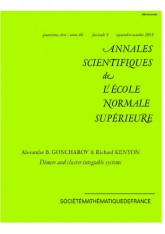Dimères et systèmes intégrables de type cluster
Dimers and cluster integrable systems

- Consulter un extrait
- Année : 2013
- Fascicule : 5
- Tome : 46
- Format : Électronique
- Langue de l'ouvrage :
Anglais - Class. Math. : 13F60, 82B20, 14H70.
- Pages : 747-813
- DOI : 10.24033/asens.2201
Au modèle des dimères sur un graphe biparti sur le tore, on associe un système intégrable quantique, qu'on appelle système intégrable de type cluster. L'espace des phases ique contient, comme ouvert dense, l'espace des modules $\mathcal {L}_\Gamma $ des fibrés en lignes avec connexion sur le graphe $\Gamma $. La somme des hamiltoniens est essentiellement la fonction de partition du modèle des dimères. Disons que deux graphes $\Gamma _1$ et $\Gamma _2$ sont équivalents si les polygones de Newton des fonctions de partitions correspondantes coïncident à translation près. Nous définissons des transformations élémentaires des graphes bipartis sur une surface, et montrons que deux graphes minimaux et équivalents sont reliés par une suite de transformations élémentaires. Pour chaque transformation élémentaire, nous définissons un isomorphisme de Poisson birationnel $\mathcal {L}_{\Gamma _1} \to \mathcal {L}_{\Gamma _2}$ donnant une équivalence des systèmes intégrables. Nous montrons que c'est une transformation de Poisson de type cluster, comme défini dans [?]. Nous montrons que, pour chaque polygone convexe entier $N$, il y a un ensemble fini et non-vide de graphes minimaux $\Gamma $ pour lesquels $N$ est le polygone de Newton de la fonction de partition sous-jacente. Recollant les variétés $\mathcal {L}_\Gamma $ pour les graphes $\Gamma $ reliés par des transformations élémentaires via les transformations de Poisson correspondantes, on construit un espace de Poisson ${\mathcal X}_N$. C'est un espace de phases naturel pour le système intégrable. Les hamiltoniens sont des fonctions sur ${\mathcal X}_N$, paramétrées par les points intérieurs de $N$. On construit des fonctions de Casimir dont les courbes de niveaux sont les feuilles symplectiques de ${\mathcal X}_N$. L'espace ${\mathcal X}_N$ a une structure de variété de Poisson de type cluster. Alors l'algèbre des fonctions régulières sur ${\mathcal X}_N$ a une $q$-déformation non-commutative à une $\ast $-algèbre ${\mathcal O}_q({\mathcal X}_N)$. Nous montrons que les hamiltoniens fournissent une famille commutative d'hamiltoniens quantiques. Avec les Casimirs quantiques ils engendrent un système intégrable quantique. La méthode générale de [?] donne une $\ast $-représentation de la $\ast $-algèbre ${\mathcal O}_q({\mathcal X}_N)$ dans un espace de Hilbert. Les hamiltoniens quantiques agissent par operateurs auto-adjoints qui commutent entre eux. Pour le cas d'un quotient de $\mathbb {Z} ^2$ sur un tore, nous avons aussi un système intégrable quantique discret, dont l'évolution est un automorphisme de type cluster de la $\ast $-algèbre ${\mathcal O}_q({\mathcal X}_N)$ commutant avec les hamiltoniens quantiques. Nous montrons que la récurrence octaédrale (récurrence de Hirota) apparaît de cette manière. À n'importe quel graphe $G$ sur le tore on associe un graphe biparti $\Gamma _G$ sur $\mathbb T$. Nous montrons que l'espace des phases $\mathcal X$ associé à $\Gamma _G$ a une sous-variété lagrangienne $\mathcal R$, définie dans chaque système de coordonnées par des équations monomiales. On l'identifie avec l'espace paramétrisant les réseaux de résistances sur $G$. L'ensemble $({\mathcal X}, {\mathcal R})$ a un grand groupe d'automorphismes de type cluster. En particulier, pour le graphe hexagonal, on trouve un système intégrable quantique discret sur $\mathcal X$ dont la restriction à $\mathcal R$ donne la récurrence cubique [?]. L'ensemble des points positifs réels ${\mathcal X}_N(\mathbb {R} _{>0})$ de l'espace des phases est bien défini. Il est isomorphe à l'espace de modules des courbes simples de Harnack avec diviseurs étudié dans [?]. Les tores de Liouville du système intégrable réel sont donnés par des produits d'ovales des courbes simples de Harnack. Dans la suite [?] de cet article, nous montrons que l'ensemble des points complexes ${\mathcal X}_N(\mathbb {C} )$ de l'espace des phases est birationnellement isomorphe à un revêtement du système de Beauville relié à la surface torique associée au polygone $N$.

